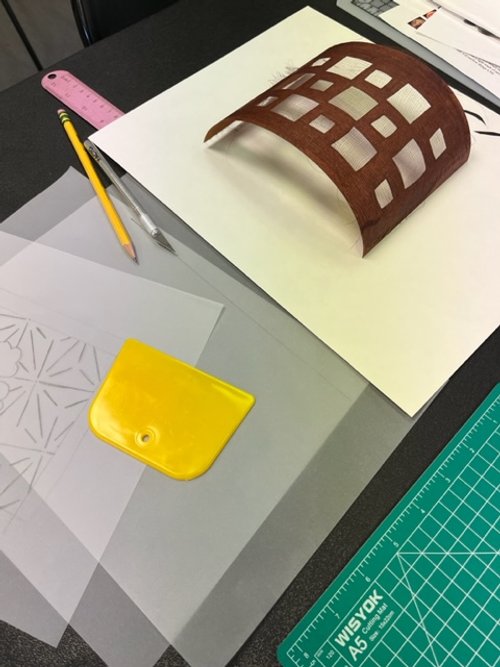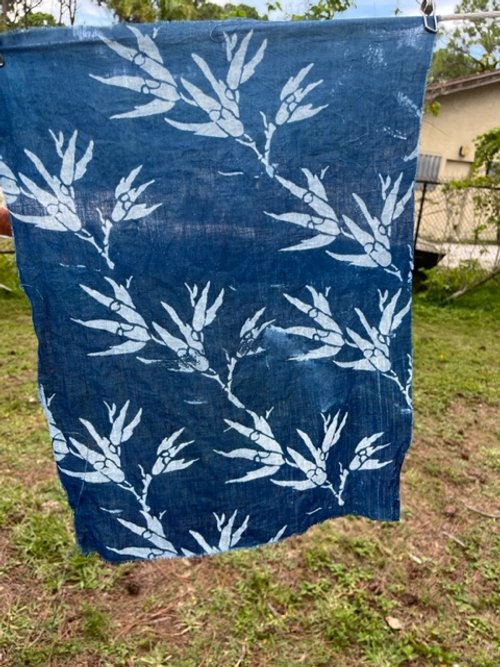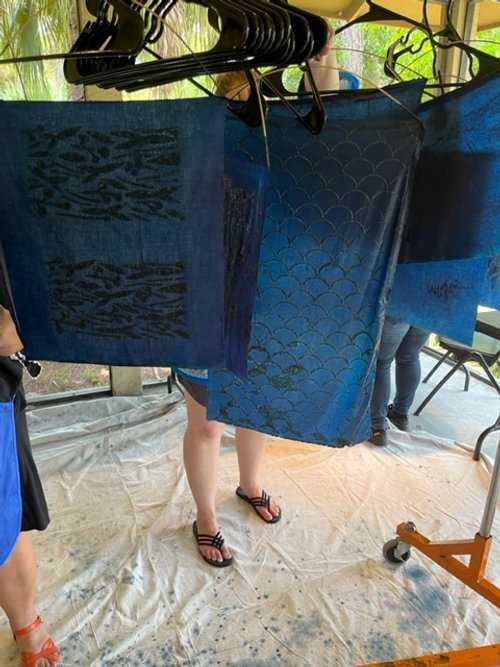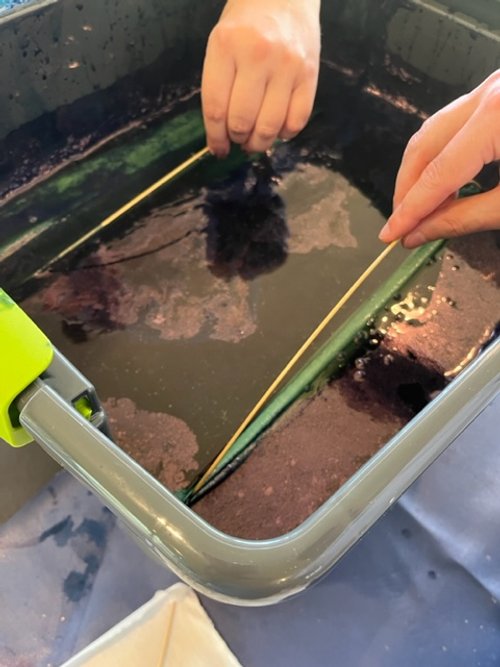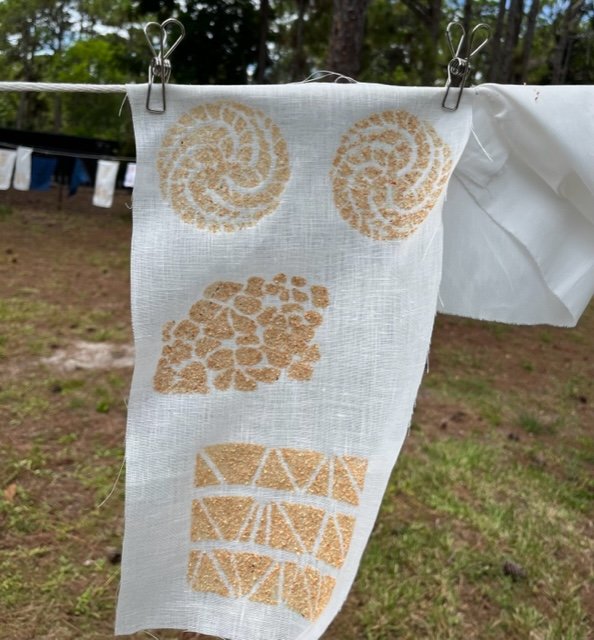Calendar of upcoming events.
Click on the Image for more Info

INTRO TO ECO-PRINT
Instructor: Suzanne Connors
Come experience the magic that happens when Eco-Printing.
Eco Printing is a process of using plants to dye and print on fiber using direct contact printing methods
During our workshop’s; participants will explore the alchemy of water, plant materials, heat, and metal and finish the class with beautiful prints on protein fibers.
In these workshop's we will be creating samples and experimenting with different protein fibers ( silk, wool). I will show you processes that have worked well for me and the equipment and bundling techniques that are used.
Although students are asked to bring a variety of leaves to class, we will also forage to identify and collect plants for printing. Emphasis will be placed on safety, best practice procedures, environmental factors and plant characteristics.
The final project will be printing on a 14” x 72” silk scarf.
This is a relaxed, fun-filled class so come prepared for the wonderful smells that can only come from eucalyptus, and other natural leaves and be open to the magic
The Intro 1-Day workshop will cover:
The materials and equipment needed for eco-printing
Fabric selections & prep (please pre scour fabrics prior to class)
Choosing the right plants for dyeing and understanding the role tannin plays
Understanding the print process on protein fibers ( we will be using protein fibers only in this workshop, for use of cellulose fibers- please check out the 3 day class)
Preparing the leaves for contact printing
Different techniques for laying out your leaves
Methods of rolling, tying and cooking bundles
https://ayafiberstudio.corsizio.com/c/641eff2b2effb6344884886e

3 Day Botanical Print Workshop
Instructor: Suzanne Connors
Eco Printing is a process of using plants to dye and print on fiber through contact printing methods. Botanical Printing is the additional of using natural dyes for added color.
During our workshop’s; participants will explore the alchemy of water, plant materials, heat, and metal and finish the class with beautiful prints on natural fiber fabrics.
In these workshop's we will be creating samples and experimenting with different fibers. We will be using natural plant materials gathered near my Florida home or brought with you from your garden. I will show you processes that have worked well for me and the equipment and bundling techniques that are used.
Be prepared for the wonderful smells that can only come from eucalyptus, and other natural leaves and be open to the magic
The 3-Day workshop will cover:
THE MATERIALS AND EQUIPMENT NEEDED FOR ECO-PRINTING
FABRIC SELECTIONS & PREP (PLEASE PRE SCOUR FABRICS PRIOR TO CLASS)
CHOOSING THE RIGHT PLANTS FOR DYEING AND UNDERSTANDING THE ROLE TANNIN PLAYS
UNDERSTANDING THE PRINT PROCESS ON BOTH PROTEIN & CELLULOSE FIBERS
MORDANTING COTTON & LINEN FIBERS: we will discuss methods of mordanting cellulose fabrics and mordant all fabrics on day 1
DIFFERENT METHODS OF PREPARING THE LEAVES FOR CONTACT PRINTING
DIFFERENT TECHNIQUES FOR LAYING OUT YOUR LEAVES
METHODS OF ROLLING, TYING AND COOKING BUNDLES
BUNDLING OVER SIZED FIBER AND CLOTHING
USING DYE BLANKETS TO GET BACKGROUND COLOR
INDIGO AND ECO PRINT
Class Time: 9:00 am-4:00pm
Web Link: https://ayafiberstudio.corsizio.com/c/6398aaaa37c937a7d807ee72

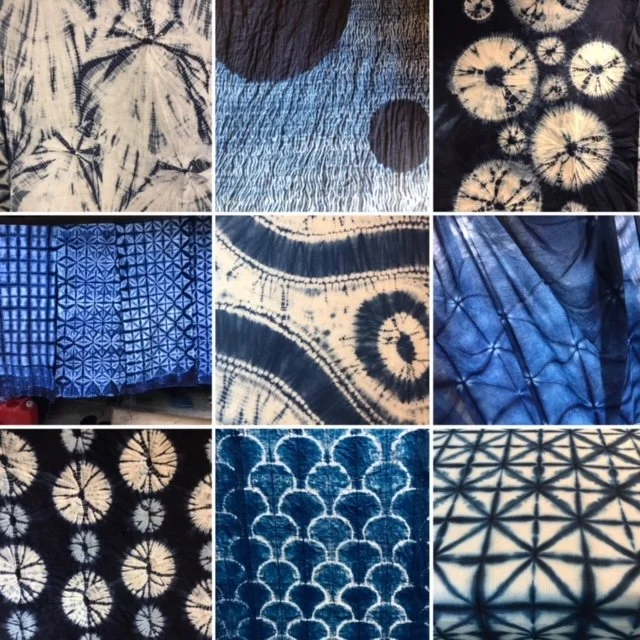

Open Studio Time
Open Studio Sessions- LAST OPEN SESSIONS in Stuart this season
4/8/2025- 4/10/2025 10:30 early session 1:30 late session
Complete those last items before we close up the Stuart Studio for the season!

MC Arts Day 2025-
As part of MartinArts commitment to promote and support the arts in the community and in collaboration with the five local high school visual arts departments, MartinArts has asked local artists to lead a 1-day, high school-level multi-media arts workshop for small groups of 15-20 students at Memorial Park and the Court House Cultural Center in downtown Stuart. The event will be held on Friday, April 11, 2025, from approximately 9 AM to 3 PM. I will be there along with my Shibori Vats to introduce students to the mystery of shibori!





SOUTH FL SURFACE DESIGN May Meeting
May meeting will be led by Kim Borowy in preparation of UNcommon Threads Exhibit

OPEN STUDIO
Enjoy uninterrupted studio time at Aya Fiber Studio! Open Studio sessions are a great opportunity to work on your projects. Whether you need assistance with your current work, have indigo projects that require dyeing, or need access to a large table or dye kitchen, our space is available for you. If you've taken a class but need a little extra time to complete your projects, we’ve got you covered. Our staff will be present to assist you as needed. The drop-in fee is $40, which includes access to our dye kitchen, print tables, sewing area, and small equipment. Just bring your materials, or feel free to purchase some from us! (Materials are not included in the fee.)

OPEN STUDIO
Enjoy uninterrupted studio time at Aya Fiber Studio! Open Studio sessions are a great opportunity to work on your projects. Whether you need assistance with your current work, have indigo projects that require dyeing, or need access to a large table or dye kitchen, our space is available for you. If you've taken a class but need a little extra time to complete your projects, we’ve got you covered. Our staff will be present to assist you as needed. The drop-in fee is $40, which includes access to our dye kitchen, print tables, sewing area, and small equipment. Just bring your materials, or feel free to purchase some from us! (Materials are not included in the fee.)


Stuart Studio Closing for Season
The Stuart Studio is closing early this year - We are preparing for a Japan Textile Adventure!
We will be closing at 3:00 PM to get ready for our trip. I will be returning the end of May and will head immediately to the NC Mountains for Summer Programming!
See you in September! (or in NC)
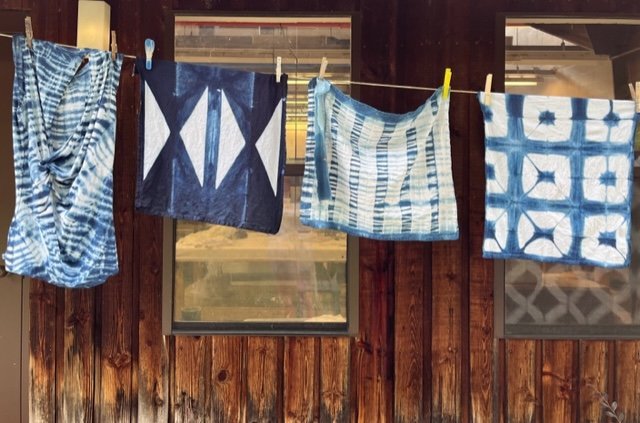
Intro to Shibori & Indigo- Wagonmaster Ranch- 6/17/2025
Indigo is an ancient dye derived from the leaves of plants and surrounded by magic, mystery, and folklore. Discover how the leaves ‘make blue’ by learning about the character and chemistry of the natural indigo vat.
The complex chemistry of the indigo vat is fascinating and students will soon appreciate how rituals have grown around the making and using of a successful vat. The unique ‘attaching’ of indigo to fiber means it is particularly suited to resist methods of dying, such as shibori, where portions of cloth are closed off to the dye or where the flow of dye is restricted. Different shades of blue build on the fabric after several dips, exhibiting the beautiful graded hues that are so typical of indigo.
SKILLS/TECHNIQUES COVERED: Students will initially learn how an indigo vat is made. A vat will be prepared in the morning and the basic chemistry explained. The natural indigo powder will be used, and the vat will be ‘reduced’ using a commercially available chemical. While the vat develops, students will be shown several shibori techniques: a folded and clamped method, and a twisted and tied technique. Students can expect to make several napkin-sized samples, a scarf, or a t-shirt


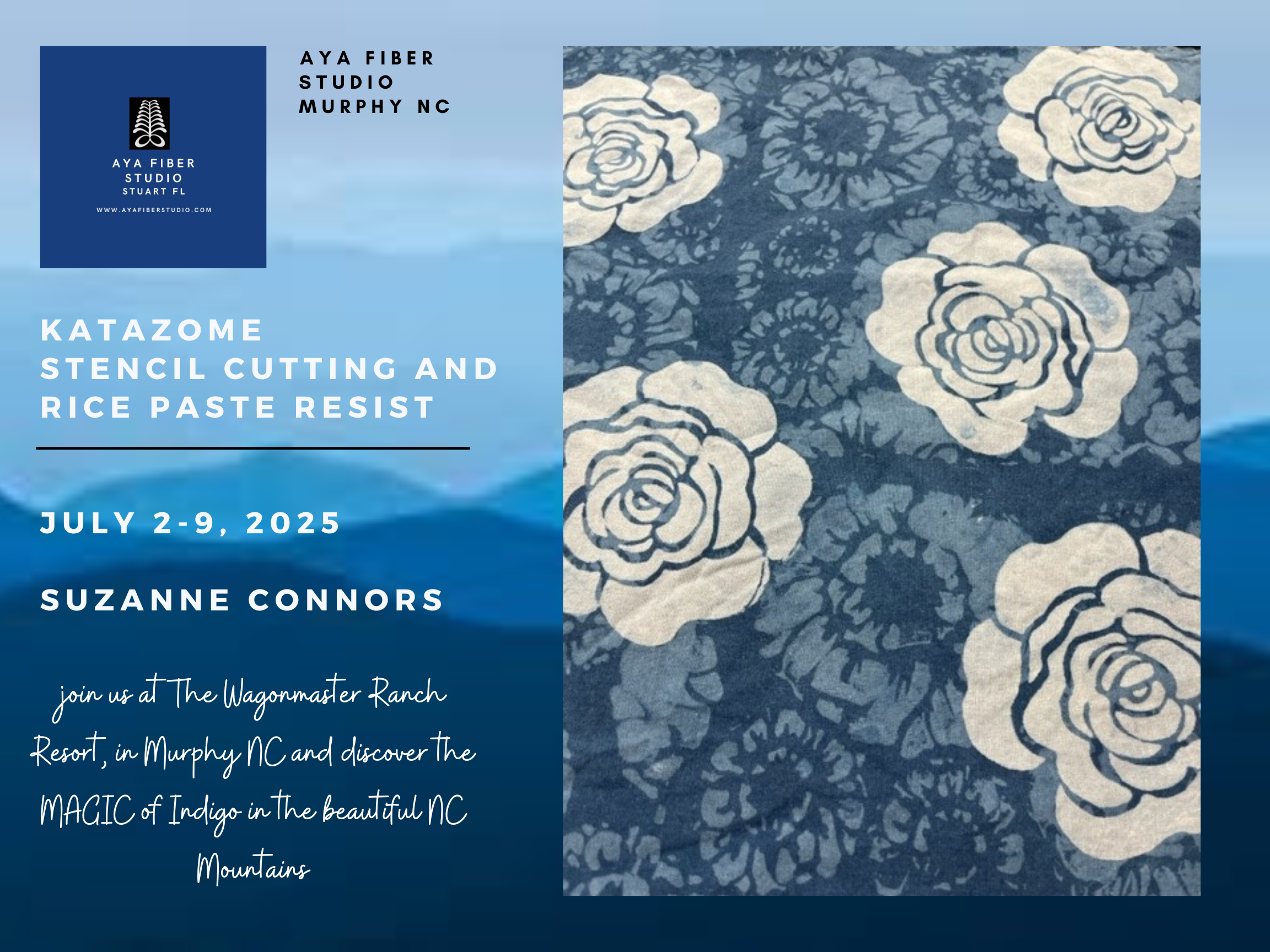






Intro to Eco printing NC
This workshop is located in Murphy North Carolina
Eco-printing is a process of using plants to dye and print on fiber through contact printing methods. Botanical Printing is the addition of using natural dyes for added color.
During this workshop; participants will explore the alchemy of water, plant materials, heat, and metal and finish the class with beautiful prints on natural fiber fabrics.
In this workshop, we will be experimenting with different fibers. We will be using North Carolina natural plant materials brought with you from your garden. I will show you processes that have worked well for me and the equipment and bundling techniques that are used.
Be prepared for the wonderful smells that can only come from natural leaves, and be open to the magic

3 Day Botanical Print- Wagonmaster Ranch, Murphy NC (Copy)
This workshop is located in Murphy North Carolina
Eco-printing is a process of using plants to dye and print on fiber through contact printing methods. Botanical Printing is the addition of using natural dyes for added color.
During this workshop; participants will explore the alchemy of water, plant materials, heat, and metal and finish the class with beautiful prints on natural fiber fabrics.
In this workshop, we will be experimenting with different fibers. We will be using North Carolina natural plant materials brought with you from your garden. I will show you processes that have worked well for me and the equipment and bundling techniques that are used.
Be prepared for the wonderful smells that can only come from natural leaves, and be open to the magic
The 3-Day workshop will cover:
THE MATERIALS AND EQUIPMENT NEEDED FOR ECO-PRINTING
FABRIC SELECTIONS & PREP (PLEASE PRE-SCOUR FABRICS BEFORE CLASS)
CHOOSING THE RIGHT PLANTS FOR DYEING AND UNDERSTANDING THE ROLE TANNIN PLAYS
UNDERSTANDING THE PRINT PROCESS ON BOTH PROTEIN & CELLULOSE FIBERS
MORDANTING COTTON & LINEN FIBERS: we will discuss methods of mordanting cellulose fabrics
DIFFERENT METHODS OF PREPARING THE LEAVES FOR CONTACT PRINTING
DIFFERENT TECHNIQUES FOR LAYING OUT YOUR LEAVES
METHODS OF ROLLING, TYING AND COOKING BUNDLES
BUNDLING OVERSIZED FIBER AND CLOTHING
USING DYE BLANKETS TO GET BACKGROUND COLOR
INDIGO AND ECO PRINT
Class Time: 9:00 am-4:00pm

Blue Ridge Mtn Arts- OUT OF THE BLUE, Shibori and Indigo Workshop
Beginning, Intermediate & Advanced
August 23, 2025-1 Session (Saturday)
10:30 am - 4:30 pm
Instructor: Suzanne Connors
Class Fee: $140.00 non-members + $45.00 Supply Fee
$126.00 BRMAA members + $45.00 Supply Fee
Indigo is an ancient dye derived from the leaves of plants and surrounded by magic, mystery, and folklore. Discover how the leaves “make blue” by learning about the character and chemistry of the natural indigo vat. The complex chemistry of the indigo vat is fascinating, and students will soon appreciate how rituals have grown around the making and using of a successful vat. The unique “attaching” of indigo to fiber means it is particularly suited to resist methods of dying, such as shibori, where portions of cloth are closed off to the dye or where the flow of dye is restricted. Different shades of blue build on the fabric after several dips, exhibiting the beautiful, graded hues, which are so typical of indigo.
Students will initially learn how an indigo vat is made. A vat will be prepared in the morning and the basic chemistry explained. The natural indigo powder will be used, and the vat will be “reduced” using a commercially available chemical. While the vat develops, students will be shown several shibori techniques: a folded and clamped method, and a twisted and tied technique. Students can expect to dye a set of four napkins in this workshop.
Please bring with you: a pair of new dishwashing-long rubber gloves, a seam-ripper or a small pair of sharp scissors, old towels, and a plastic bag to take wet items home. Please wear an old shirt or apron, pants, and closed-toe shoes.
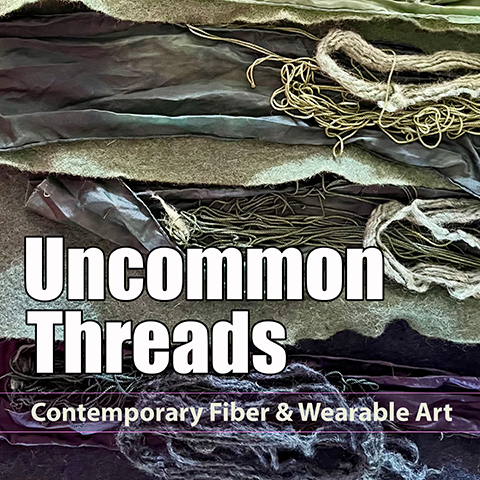

Intro to Shibori and Indigo
Indigo is an ancient dye derived from the leaves of plants and surrounded by magic, mystery, and folklore. Discover how the leaves ‘make blue’ by learning about the character and chemistry of the natural indigo vat.
The complex chemistry of the indigo vat is fascinating and students will soon appreciate how rituals have grown around the making and using of a successful vat. The unique ‘attaching’ of indigo to fiber means it is particularly suited to resist methods of dying, such as shibori, where portions of cloth are closed off to the dye or where the flow of dye is restricted. Different shades of blue build on the fabric after several dips, exhibiting the beautiful graded hues that are so typical of indigo.
SKILLS/TECHNIQUES COVERED: Students will initially learn how an indigo vat is made. A vat will be prepared in the morning and the basic chemistry explained. The natural indigo powder will be used, and the vat will be ‘reduced’ using a commercially available chemical. While the vat develops, students will be shown several shibori techniques: a folded and clamped method, and a twisted and tied technique.
LEVEL: Beginner and intermediate
LOCATION: STUART STUDIO
Students will be given authentic Japanese tenugi fabric for class instruction
https://ayafiberstudio.corsizio.com/event/674884f4aa4a191770efdd16



INTRO TO ECO-PRINT
Instructor: Suzanne Connors
Come experience the magic that happens when Eco-Printing.
Eco Printing is a process of using plants to dye and print on fiber using direct contact printing methods
During our workshop’s; participants will explore the alchemy of water, plant materials, heat, and metal and finish the class with beautiful prints on protein fibers.
In these workshop's we will be creating samples and experimenting with different protein fibers ( silk, wool). I will show you processes that have worked well for me and the equipment and bundling techniques that are used.
Although students are asked to bring a variety of leaves to class, we will also forage to identify and collect plants for printing. Emphasis will be placed on safety, best practice procedures, environmental factors and plant characteristics.
The final project will be printing on a 14” x 72” silk scarf.
This is a relaxed, fun-filled class so come prepared for the wonderful smells that can only come from eucalyptus, and other natural leaves and be open to the magic
The Intro 1-Day workshop will cover:
The materials and equipment needed for eco-printing
Fabric selections & prep (please pre scour fabrics prior to class)
Choosing the right plants for dyeing and understanding the role tannin plays
Understanding the print process on protein fibers ( we will be using protein fibers only in this workshop, for use of cellulose fibers- please check out the 3 day class)
Preparing the leaves for contact printing
Different techniques for laying out your leaves
Methods of rolling, tying and cooking bundles
https://ayafiberstudio.corsizio.com/c/641eff2b2effb6344884886e

3 Day Botanical Print Workshop
Instructor: Suzanne Connors
Eco Printing is a process of using plants to dye and print on fiber through contact printing methods. Botanical Printing is the additional of using natural dyes for added color.
During our workshop’s; participants will explore the alchemy of water, plant materials, heat, and metal and finish the class with beautiful prints on natural fiber fabrics.
In these workshop's we will be creating samples and experimenting with different fibers. We will be using natural plant materials gathered near my Florida home or brought with you from your garden. I will show you processes that have worked well for me and the equipment and bundling techniques that are used.
Be prepared for the wonderful smells that can only come from eucalyptus, and other natural leaves and be open to the magic
The 3-Day workshop will cover:
THE MATERIALS AND EQUIPMENT NEEDED FOR ECO-PRINTING
FABRIC SELECTIONS & PREP (PLEASE PRE SCOUR FABRICS PRIOR TO CLASS)
CHOOSING THE RIGHT PLANTS FOR DYEING AND UNDERSTANDING THE ROLE TANNIN PLAYS
UNDERSTANDING THE PRINT PROCESS ON BOTH PROTEIN & CELLULOSE FIBERS
MORDANTING COTTON & LINEN FIBERS: we will discuss methods of mordanting cellulose fabrics and mordant all fabrics on day 1
DIFFERENT METHODS OF PREPARING THE LEAVES FOR CONTACT PRINTING
DIFFERENT TECHNIQUES FOR LAYING OUT YOUR LEAVES
METHODS OF ROLLING, TYING AND COOKING BUNDLES
BUNDLING OVER SIZED FIBER AND CLOTHING
USING DYE BLANKETS TO GET BACKGROUND COLOR
INDIGO AND ECO PRINT
Class Time: 9:00 am-4:00pm
Web Link: https://ayafiberstudio.corsizio.com/c/6398aaaa37c937a7d807ee72


Intro to Shibori and Indigo
Indigo is an ancient dye derived from the leaves of plants and surrounded by magic, mystery, and folklore. Discover how the leaves ‘make blue’ by learning about the character and chemistry of the natural indigo vat.
The complex chemistry of the indigo vat is fascinating and students will soon appreciate how rituals have grown around the making and using of a successful vat. The unique ‘attaching’ of indigo to fiber means it is particularly suited to resist methods of dying, such as shibori, where portions of cloth are closed off to the dye or where the flow of dye is restricted. Different shades of blue build on the fabric after several dips, exhibiting the beautiful graded hues that are so typical of indigo.
SKILLS/TECHNIQUES COVERED: Students will initially learn how an indigo vat is made. A vat will be prepared in the morning and the basic chemistry explained. The natural indigo powder will be used, and the vat will be ‘reduced’ using a commercially available chemical. While the vat develops, students will be shown several shibori techniques: a folded and clamped method, and a twisted and tied technique.
LEVEL: Beginner and intermediate
LOCATION: STUART STUDIO
Students will be given authentic Japanese tenugi fabric for class instruction
https://ayafiberstudio.corsizio.com/event/674884f4aa4a191770efdd16

Katazome- Japanese Rice Paste Resist
The traditional Japanese art of katazome is ancient. Kata means stencil and zome is a form of the word someru which means to dye- hence katazome (stencil dyeing)
The basic process of stencil dyeing is not complicated. First, a stencil is cut and placed on a piece of fabric. Next resist paste is applied through the stencil.
The stencil is then removed, and the pasted fabric is allowed to dry in the sunlight. Fabric is then treated with sizing if going to be dyed with pigments. Fabric is then indigo dyed or the color pigments brushed on.
Finally, the fabrics are soaked in water to remove the paste.
The steps of creating Katazome must be followed in sequence, and timing is essential.






Intro to Shibori and Indigo
Indigo is an ancient dye derived from the leaves of plants and surrounded by magic, mystery, and folklore. Discover how the leaves ‘make blue’ by learning about the character and chemistry of the natural indigo vat.
The complex chemistry of the indigo vat is fascinating and students will soon appreciate how rituals have grown around the making and using of a successful vat. The unique ‘attaching’ of indigo to fiber means it is particularly suited to resist methods of dying, such as shibori, where portions of cloth are closed off to the dye or where the flow of dye is restricted. Different shades of blue build on the fabric after several dips, exhibiting the beautiful graded hues that are so typical of indigo.
SKILLS/TECHNIQUES COVERED: Students will initially learn how an indigo vat is made. A vat will be prepared in the morning and the basic chemistry explained. The natural indigo powder will be used, and the vat will be ‘reduced’ using a commercially available chemical. While the vat develops, students will be shown several shibori techniques: a folded and clamped method, and a twisted and tied technique.
LEVEL: Beginner and intermediate
LOCATION: STUART STUDIO
Students will be given authentic Japanese tenugi fabric for class instruction
https://ayafiberstudio.corsizio.com/event/674884f4aa4a191770efdd16

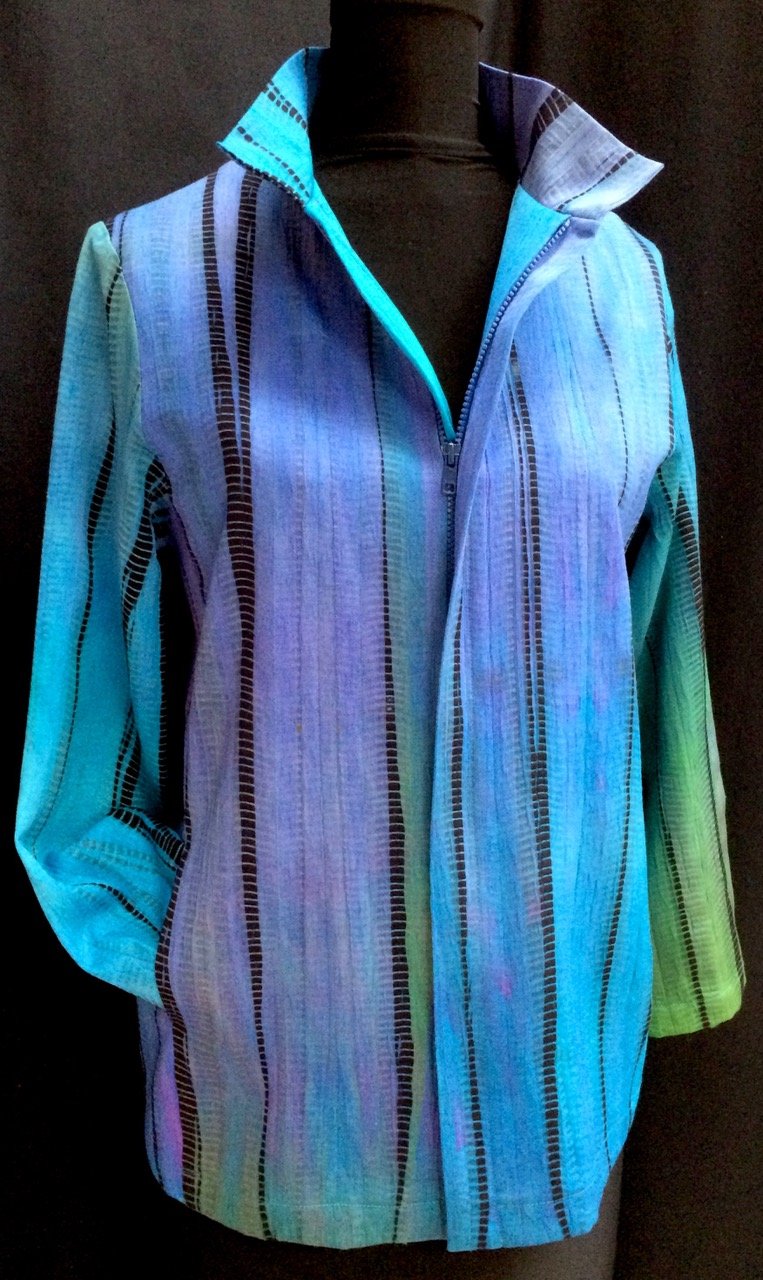
Depth and Mystery in Shibori with DOSHI
With Shibori the dyer works in concert with the materials, not to overcome their limitations, but to allow them full expression. An element of the unexpected is always present. Chance and accident give life to the Shibori process, contributing to its special magic, appeal, and individual expression.
We will explore several methods of enhancing the fabric; creating depth and mystery through color and texture, and increasing the complexity of imagery and pattern.
various methods of shaped resist
layering resist techniques
adding color through pour dyeing and immersion dyeing
discharge
We will also look at color—inspiration, choosing, and mixing—with acid dyes on a variety of silk fabrics. Layering color upon color adds visual depth and allows the fabric to vibrate visually.


Intro to Shibori and Indigo
Indigo is an ancient dye derived from the leaves of plants and surrounded by magic, mystery, and folklore. Discover how the leaves ‘make blue’ by learning about the character and chemistry of the natural indigo vat.
The complex chemistry of the indigo vat is fascinating and students will soon appreciate how rituals have grown around the making and using of a successful vat. The unique ‘attaching’ of indigo to fiber means it is particularly suited to resist methods of dying, such as shibori, where portions of cloth are closed off to the dye or where the flow of dye is restricted. Different shades of blue build on the fabric after several dips, exhibiting the beautiful graded hues that are so typical of indigo.
SKILLS/TECHNIQUES COVERED: Students will initially learn how an indigo vat is made. A vat will be prepared in the morning and the basic chemistry explained. The natural indigo powder will be used, and the vat will be ‘reduced’ using a commercially available chemical. While the vat develops, students will be shown several shibori techniques: a folded and clamped method, and a twisted and tied technique.
LEVEL: Beginner and intermediate
LOCATION: STUART STUDIO
Students will be given authentic Japanese tenugi fabric for class instruction
https://ayafiberstudio.corsizio.com/event/674884f4aa4a191770efdd16

Visual Haiku with Flax Fiber Collage with Jacqueline Mallegni
Wabi-Sabi, the Japanese art of impermanence, will be the thread of our creative process as we explore the myriad possibilities with flax roving and other natural materials for collage and visual haiku.
Explore concepts of sense of place and your relationship to place through materiality. We will focus on transforming natural materials into collages through texture, perception, and ways of seeing. We will dive into mark-making with ink, dye, and stains. Discover how to use simple materials for self-expression.
Details:
Take a deep dive into fiber art through collage and materiality. Explore the nature of textured paper combined with foraged materials, thread, ink, and dye.
Immerse yourself in a contemplative creative process.
Principal areas of focus are non-traditional papermaking with flax fiber for collage.
Develop a project or idea using collage concepts for decorative panels.
Receive daily process-oriented demonstrations and visual presentations in a collaborative environment.
Implement new techniques with natural fibers.
The workshop is designed to alternate between focused instructional demonstrations and uninterrupted time for art-making between sessions.
All skill levels are welcome.

Develop a Personal Artistic Vocabulary on Paper with Claudia Lee
Our focus for this workshop will be for each student to develop their own personal design vocabulary on which to build a body of work.
This vocabulary will take the form of text, images and a personal color palate that will be developed through the exploration of surface design techniques including wax resist, mono-printing on a gel plate, paste papers, image transfers, collage, stitching, mark-making and more.
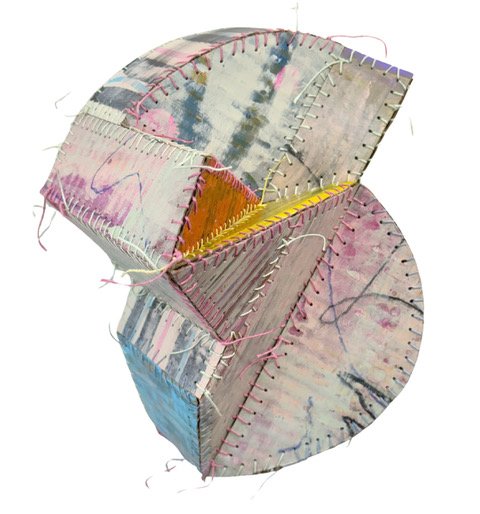
Sculptural Stitchery Instructor: Susan Stover
Merging the detailed nature of stitching and the physical, three-dimensional aspects of sculpture, is the focus of this workshop.
We’ll examine how traditional and nontraditional hand stitching methods can play a powerful role, conceptually and materially, in sculpture. By introducing a rich historical context, inspiration from contemporary artists, and a tangible experience, we’ll explore new possibilities for your work.

Interaction! Shibori Indigo Over Color with Carol Anne Grotrian
Experience the excitement of dyeing indigo patterns over color. Results can range from dramatic to subtle, with a bonus when the interaction of indigo and fiber-reactive dyes creates interesting haloes of color. The class will include instructions on mixing fiber-reactive colors and using an indigo vat and various Shibori techniques. There will be lots of time to create beautiful, unique fabrics as students team up to create solid colors that everyone can overdye in indigo shibori patterns.
While it is NOT required, students are encouraged to come up with a project in mind, such as a wall hanging, quilt, garment, or other textile.
No experience is necessary; experienced dyers are welcome.



Light and Lacy with Valerie Goodwin
Create lovely collages using shapes such as map elements, floral motifs, and /or geometric patterns and shapes using opaque and sheer fabrics.
Explore the potential of intricately cut surfaces created with the Silhouette Cameo electronic cutter. This popular machine can provide precision cutting that leads to beautiful detail.
The instructor will also provide the opportunity to work with elements that are pre-cut with a laser cutter.





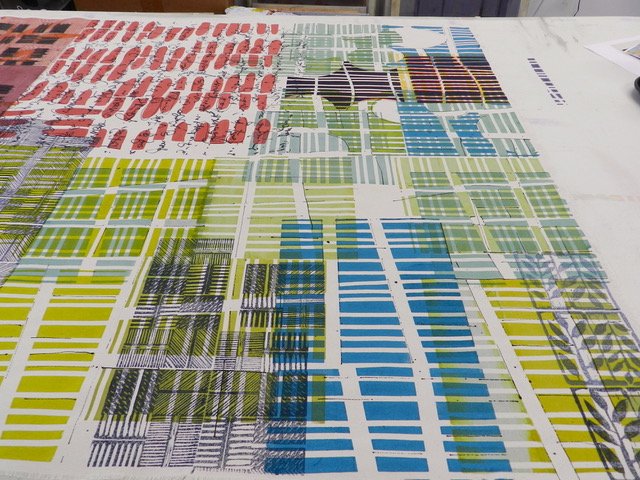




Surface Design w Betty Busby
Welcome to my new techniques class!
We’ll cover multiple new ways of expressing ourselves on fabric.
Transfer printing: we’ll use non-toxic dye (provided by me) to transfer designs from paper to synthetic materials, using heat.
It’s a very different way of creating designs, as compositions can be created on dry paper with collage techniques.
A huge variety of synthetic materials can be used, including sheers.
Also, botanicals can be used with fantastic results, matching or exceeding results achieved through eco printing. Post production: learn how to use various media such as gel pens, markers, and colored pencils, to enhance your stitching after quilting.
Watercolor techniques on fabric: We’ll use fabric paints on cotton to achieve similar effects of watercolor paint on paper, only it is permanent. These can make a great base for hand or machine stitching.



INTRO TO ECO-PRINT
Instructor: Suzanne Connors
Come experience the magic that happens when Eco-Printing.
Eco Printing is a process of using plants to dye and print on fiber using direct contact printing methods
During our workshop’s; participants will explore the alchemy of water, plant materials, heat, and metal and finish the class with beautiful prints on protein fibers.
In these workshop's we will be creating samples and experimenting with different protein fibers ( silk, wool). I will show you processes that have worked well for me and the equipment and bundling techniques that are used.
Although students are asked to bring a variety of leaves to class, we will also forage to identify and collect plants for printing. Emphasis will be placed on safety, best practice procedures, environmental factors and plant characteristics.
The final project will be printing on a 14” x 72” silk scarf.
This is a relaxed, fun-filled class so come prepared for the wonderful smells that can only come from eucalyptus, and other natural leaves and be open to the magic
The Intro 1-Day workshop will cover:
The materials and equipment needed for eco-printing
Fabric selections & prep (please pre scour fabrics prior to class)
Choosing the right plants for dyeing and understanding the role tannin plays
Understanding the print process on protein fibers ( we will be using protein fibers only in this workshop, for use of cellulose fibers- please check out the 3 day class)
Preparing the leaves for contact printing
Different techniques for laying out your leaves
Methods of rolling, tying and cooking bundles
https://ayafiberstudio.corsizio.com/c/641eff2b2effb6344884886e

3 Day Botanical Print Workshop
Instructor: Suzanne Connors
Eco Printing is a process of using plants to dye and print on fiber through contact printing methods. Botanical Printing is the additional of using natural dyes for added color.
During our workshop’s; participants will explore the alchemy of water, plant materials, heat, and metal and finish the class with beautiful prints on natural fiber fabrics.
In these workshop's we will be creating samples and experimenting with different fibers. We will be using natural plant materials gathered near my Florida home or brought with you from your garden. I will show you processes that have worked well for me and the equipment and bundling techniques that are used.
Be prepared for the wonderful smells that can only come from eucalyptus, and other natural leaves and be open to the magic
The 3-Day workshop will cover:
THE MATERIALS AND EQUIPMENT NEEDED FOR ECO-PRINTING
FABRIC SELECTIONS & PREP (PLEASE PRE SCOUR FABRICS PRIOR TO CLASS)
CHOOSING THE RIGHT PLANTS FOR DYEING AND UNDERSTANDING THE ROLE TANNIN PLAYS
UNDERSTANDING THE PRINT PROCESS ON BOTH PROTEIN & CELLULOSE FIBERS
MORDANTING COTTON & LINEN FIBERS: we will discuss methods of mordanting cellulose fabrics and mordant all fabrics on day 1
DIFFERENT METHODS OF PREPARING THE LEAVES FOR CONTACT PRINTING
DIFFERENT TECHNIQUES FOR LAYING OUT YOUR LEAVES
METHODS OF ROLLING, TYING AND COOKING BUNDLES
BUNDLING OVER SIZED FIBER AND CLOTHING
USING DYE BLANKETS TO GET BACKGROUND COLOR
INDIGO AND ECO PRINT
Class Time: 9:00 am-4:00pm
Web Link: https://ayafiberstudio.corsizio.com/c/6398aaaa37c937a7d807ee72


Morakami (Copy) (Copy)
Katazome Workshop
https://morikami.org/event/shibori-indigo-workshop/



Japan Textile Trip FALL 2027
This exclusive Textile tour offers a unique opportunity to immerse yourself in the profound tradition and beauty of Japanese indigo dyeing and traditional Japanese Craft. Tailored for both beginners and experienced textile artists, the workshops are meticulously designed to provide comprehensive knowledge and hands-on practice. Participants will gain an in-depth understanding of the intricate process of creating the deep, rich blue hues that indigo is renowned for, ultimately fostering a profound appreciation for this ancient craft. Whether your goal is to enhance your artistic skills or indulge in a cultural experience, this program promises to be both enlightening and unforgettable.
Throughout this journey, participants will engage in multiple private hands-on indigo sessions. You will learn the complex process of making sukumo, the traditional Japanese compost method of producing indigo dye, which involves the fermentation of indigo leaves to create a natural dye. Additionally, you will explore various resist dyeing techniques such as stencil cutting and katazome, which utilizes rice paste to create detailed patterns; kasuri, a Japanese ikat technique known for its distinctive, blurred designs; and shibori, an ancient tie-dye resist method that results in exquisite, organic patterns.
Participants will have the opportunity to interact with a diverse range of individuals deeply connected to the art of indigo dyeing. This includes indigo farmers who cultivate the plants, ‘National Living Treasure’ artisans recognized for their exceptional craftsmanship, innovative young practitioners who are redefining traditional techniques, artists who incorporate indigo into their works, and experts and collectors who possess a deep appreciation for indigo textiles.
Be inspired by the remarkable design and craftsmanship showcased during visits to specialist indigo museums, galleries, and studios. Attendees will benefit from insightful talks by artisans, offering an in-depth look into the history and evolution of indigo dyeing. For those interested, there will also be opportunities to purchase stunning indigo textiles and handcrafted items, each piece reflecting the dedication and skill of its creator.
Beyond the hands-on indigo experiences, participants will have the chance to immerse themselves in Japan's rich cultural heritage. This includes participating in a traditional tea ceremony, which epitomizes the principles of harmony, respect, purity, and tranquility. Additionally, visits to magnificent temples and shrines, each with unique architecture and history, will be arranged. Cultural sites in Kyoto, Tokushima, and Kurume—cities lauded for their historical significance and beauty—will also be explored. We will also discover Okayama's historic sites and gardens, followed by Naoshima Island’s art museums.
Join us for an experience of traditional Japanese culture and hospitality, in the company of a small group of like-minded textile and indigo enthusiasts. This journey is not merely about acquiring a new craft; it is about connecting with a rich cultural heritage and becoming part of a community united by a shared passion for indigo.

Encaustic Embellishment Extravaganza with Lorraine Glessner
Explore flexible and exciting encaustic painting techniques to create complex, multi-layered pieces with intricate patterns and expressive personal surfaces. With an emphasis on mixed media, methods and materials covered in this workshop include the use of organic and geometric form, realistic and abstract imagery, patterned collage, photo transfer, stencils, candy molds, embossing foils, and branding (creating marks with heated metal and wood burning tools). Using pattern and repetition as content itself, to tell a story, support and/or strengthen the message will also be discussed. Students will leave enriched, inspired and closer to their own voice and vision. All levels welcome.



Sashiko Class Core & Essence, plus Application
Learn the spirit and skills of sashiko stitching from the authentic sashiko artist, Atsushi Futatsuya!
Sashiko is the traditional Japanese art of decorative mending stitches. In this 3-day workshop, you will learn about the art and history of Sashiko, how to use a long needle and make beautiful stitches, and how to find joy in stitching. You will learn how to transfer patterns to fabric and we will discuss ideas for future projects and how to use sashiko as part of a mindful mending practice. This is a unique opportunity to learn authentic Sashiko stitching from a traditional master, Atsushi Futatsuya, a third-generation Sashiko artist. You will be learning directly from his traditional family wisdom and years of experience as a Sashiko educator. Following a lecture and demonstration by Atsushi, students will practice this meditative art and advance their Sashiko skills with lots of hands-on guidance.




Natural Dyeing Seminar : Classical Natural Dyes Created in Modern Setting
Natural Dyeing of the 18th Century, in a Modern Setting: Classical Natural Dyes at your Fingertips
Create stunning colors from plans, inspired by the recipes of the old masters, adjusted to fit a modern dye kitchen.
Day one:
On the first day, you learn about the systems and economics of the 18th-century natural dye industry. Specifically in the South of France, which was the leading economic force of that century.
We learn about the master dyers of the era and their recipe books.
Practical instructions:
Correct cleaning of natural fibers
Water ratios
WOF calculations
Record keeping and building a library.
Practice and test: cleaning the materials you will be using for the rest of the trials.
Color: Learn how to set up an indigo bath
Day two
We will dye base colors of different shades of blue according to 18th-century shade cards.
milky blue
azure blue
Kings blue
You will learn how to dye correctly, and how to maintain your vat for continued dyeing.
You will learn about the mordanting process for wool, and we will mordant part of our fabric for the following steps.
Day three
The yellows
You will learn a classical mordant bath for our wool fabric.
We will create a classical weld dye bath and a buckthorn berry bath and dye our yellow samples.
We will create
Lemon Yellow
Warm Yellow
Vert Gay (cheerful Green)
Vert d’Herbe (herb green)
Day four
Going all out with Madder and Cochineal
Today you will learn how to create vibrant reds with madder
We will create Purples by over-dyeing our blue samples
We will create ORANGE by over-dyeing yellow samples
Madder red
Scarlet red
Golden Cinnamon
Violet
Lila
Day Five
Greys, taupe and more.
Learn how to reuse your dye baths and combine them with mordants to create even more stunning shades.
We will finish our dyeing and collect and cut all the samples to make your sample collection for future reference.



Lunar New Year
The Year of the Snake is the year 2025 according to the Chinese zodiac. The snake is the sixth animal in the zodiac cycle. The Year of the Snake began on January 29, 2025, which was the date of the Lunar New Year.
What does the Year of the Snake mean?
The snake is said to symbolize wisdom, renewal, and transformation.
People born in the Year of the Snake are thought to be calm, rational, and strategic.
The Year of the Snake is a time to celebrate the end of winter and the beginning of spring.
How is the Year of the


Marbling: Eco-Friendly Fabric Printing with Natalie Stopka
Fabric marbling is a wonderful blend of monotype printing, repeat pattern development, and color
play! In this three-day workshop, students will learn the fundamentals of fabric marbling, including
how to select materials and manipulate the chemistry of the marbling tray. …….


Lisa Binkley Workshop
Dyeing with plant pigments has been practiced for as long as humans have made cloth and wished to beautify it. Printing with plants has been practiced for generations through such
traditions as Easter egg adornment and in the past few decades as a way to adorn fabrics.
During this five-day workshop, students learn about the history of dyeing and printing with plants; how to prepare fabric for dyeing and printing; ways to secure and alter botanical dye color on cloth; and many ways to get patterns and images on fabric with plants.
During the first three days, we will use a variety of local plant materials as well as other botanical dyes to create color and patterns on our fabrics. We will focus on printing plant material onto fabrics; dyeing solid and mottled colors with botanical pigments; printing and dyeing together; and using some shibori techniques in conjunction with botanical printing and dyeing.
During the fourth and fifth days, students will learn and practice hand piecing, contemporary applique, and hand-stitching/quilting techniques suited to these fabrics. They will then use their recently dyed fabrics to begin an art quilt, art fabric panel, or garment.
https://ayafiberstudio.corsizio.com/event/65eb33a1f69a5a52a3db5792

PATTERNING THE PATTERNS with Amy Nguyen-
PATTERNING THE PATTERN
Art may be considered man-made order or structure, while craft contains the accumulation of technical skill in daily practice. Both are necessary for the creative exploration of pattern and form.
Understanding the elements and principles of art through playful technical exercises in surface design and stitching will allow for creative freedom in making textiles for the body or home. We will explore surface design and structural techniques with brush, dye, paper, cloth, scissors, needle, and thread. Journals encouraged.
We will utilize natural fibers and both man-made and natural dyes to resist dyeing and printing. Honing our visual language and creating a textile pattern will be possible through further experimentation of elements such as line, shape, color, value, and texture and exploring size, scale, repetition, rhythm, and balance. We may further develop our textile with a historic pattern shape in mind, such as the beautiful kimono. A variety of seam construction and finishing techniques will be demonstrated.
https://ayafiberstudio.corsizio.com/event/65ec86153112f8c7e74634a7

Open Studio Time
Open Studio Time- Drop In $40
10:00- 4:30 daily (2 Sessions per day)
10:00- 1:00
1:30- 4:30


Open Studio Time
Open Studio Time- Drop In $40
10:00- 4:30 daily (2 Sessions per day)
10:00- 1:00
1:30- 4:30

Open Studio Time
Open Studio Time- Drop In $40
10:00- 4:30 daily (2 Sessions per day)
10:00- 1:00
1:30- 4:30



Katazome: Japanese Paste Resist with Suzanne Connors
The traditional Japanese art of katazome is ancient. Kata means stencil and zome is a form of the word someru which means to dye- hence katazome (stencil dyeing)
The basic process of stencil dyeing is not complicated. First a stencil is cut and placed on a piece of fabric. Next resist paste is applied through the stencil. The
Stencil is then removed, and the pasted fabric is allowed to dry in the sunlight. Fabric is then treated with sizing if going to be dyed with pigments. Fabric is then dyed or the coler pigments brushed on.
Finally, the fabrics soaked in water to remove the paste.
The steps of katazome must be followed in sequence, and timing is essential.

Open Studio Time
Open Studio Sessions- LAST OPEN SESSIONS in Stuart this year
10:30 early session 1:30 late session
















